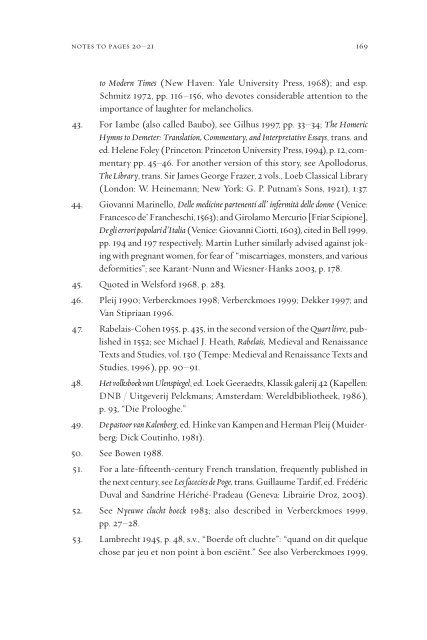Pieter Bruegel and the Art of Laughter - AAAARG.ORG
Pieter Bruegel and the Art of Laughter - AAAARG.ORG
Pieter Bruegel and the Art of Laughter - AAAARG.ORG
Create successful ePaper yourself
Turn your PDF publications into a flip-book with our unique Google optimized e-Paper software.
notes to pages 20–21 169<br />
to Modern Times (New Haven: Yale University Press, 1968); <strong>and</strong> esp.<br />
Schmitz 1972, pp. 116–156, who devotes considerable attention to <strong>the</strong><br />
importance <strong>of</strong> laughter for melancholics.<br />
43. For Iambe (also called Baubo), see Gilhus 1997, pp. 33–34; The Homeric<br />
Hymns to Demeter: Translation, Commentary, <strong>and</strong> Interpretative Essays, trans. <strong>and</strong><br />
ed. Helene Foley (Princeton: Princeton University Press, 1994), p. 12, commentary<br />
pp. 45–46. For ano<strong>the</strong>r version <strong>of</strong> this story, see Apollodorus,<br />
The Library, trans. Sir James George Frazer, 2 vols., Loeb Classical Library<br />
(London: W. Heinemann; New York: G. P. Putnam’s Sons, 1921), 1:37.<br />
44. Giovanni Marinello, Delle medicine partenenti all’ infermità delle donne (Venice:<br />
Francesco de’ Francheschi, 1563); <strong>and</strong> Girolamo Mercurio [Friar Scipione],<br />
De gli errori popolari d’Italia (Venice: Giovanni Ciotti, 1603), cited in Bell 1999,<br />
pp. 194 <strong>and</strong> 197 respectively. Martin Lu<strong>the</strong>r similarly advised against joking<br />
with pregnant women, for fear <strong>of</strong> “miscarriages, monsters, <strong>and</strong> various<br />
deformities”; see Karant-Nunn <strong>and</strong> Wiesner-Hanks 2003, p. 178.<br />
45. Quoted in Welsford 1968, p. 283.<br />
46. Pleij 1990; Verberckmoes 1998; Verberckmoes 1999; Dekker 1997; <strong>and</strong><br />
Van Stipriaan 1996.<br />
47. Rabelais-Cohen 1955, p. 435, in <strong>the</strong> second version <strong>of</strong> <strong>the</strong> Quart livre, published<br />
in 1552; see Michael J. Heath, Rabelais, Medieval <strong>and</strong> Renaissance<br />
Texts <strong>and</strong> Studies, vol. 130 (Tempe: Medieval <strong>and</strong> Renaissance Texts <strong>and</strong><br />
Studies, 1996 ), pp. 90–91.<br />
48. Het volksboek van Ulenspiegel, ed. Loek Geeraedts, Klassik galerij 42 (Kapellen:<br />
DNB / Uitgeverij Pelckmans; Amsterdam: Wereldbiblio<strong>the</strong>ek, 1986 ),<br />
p. 93, “Die Prolooghe.”<br />
49. De pastoor van Kalenberg, ed. Hinke van Kampen <strong>and</strong> Herman Pleij (Muiderberg:<br />
Dick Coutinho, 1981).<br />
50. See Bowen 1988.<br />
51. For a late-fifteenth-century French translation, frequently published in<br />
<strong>the</strong> next century, see Les facecies de Poge, trans. Guillaume Tardif, ed. Frédéric<br />
Duval <strong>and</strong> S<strong>and</strong>rine Hériché-Pradeau (Geneva: Librairie Droz, 2003).<br />
52. See Nyeuwe clucht boeck 1983; also described in Verberckmoes 1999,<br />
pp. 27–28.<br />
53. Lambrecht 1945, p. 48, s.v., “Boerde <strong>of</strong>t cluchte”: “qu<strong>and</strong> on dit quelque<br />
chose par jeu et non point à bon esciënt.” See also Verberckmoes 1999,












